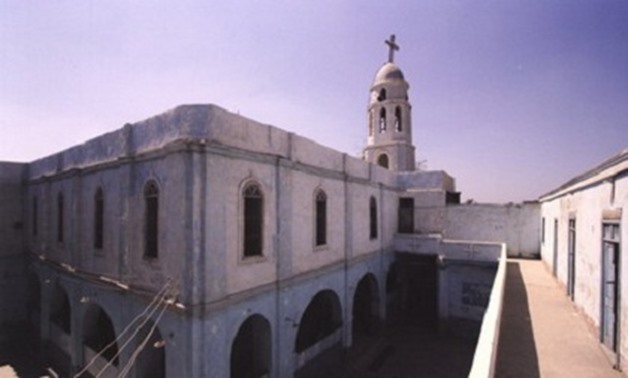
Deir el-Garnous church – V Egypt Tours
MINYA, Egypt – 13 November 2017: Holding child Christ to her chest, Virgin Mary took a wooden sailboat anchored to the Maadi shore in Cairo. Saint Joseph helped Mary to the boat, as she got ready for sailing down the river.
The Holy Family spent five days on its journey down the Nile, blessing the cities of Upper Egypt. Child Christ caused water to spring from an empty well. With his small palm, he stopped a rock from falling on the passengers, and the mountain is thus named Gabal al-Kaff (Mountain of the Palm). A village is also called Deir Abi Esus, meaning the House of Jesus. Centuries later, Arabs altered the name to Deir al-Garnous.
 Deir el-Garnous church – V Egypt Tours
Deir el-Garnous church – V Egypt Tours
From Maghagha, a town in Minya, the car took us to Deir al-Garnous village. Locals installed speed bumps themselves in front of their houses. The lanes were too narrow that they would not accommodate two vehicles at the same time. We found the village with a lot of difficulty. When we got there, we noticed that the metal doors of people’s houses were adorned with crosses, as if people wanted to assert the Christian identity of their village. For many years, Muslims have not resided in this village, and the people do not welcome strangers among them.
The people of Deir al-Garnous work in agriculture, trade and transportation of goods. Toward the middle of the village, we could see the beacon of the Virgin Mary Church. There were huge domes and a long beacon towering above the surrounding houses built by peasants and merchants who could build their houses using red bricks after many encroachments on farmland.
 Deir el-Garnous church – V Egypt Tours
Deir el-Garnous church – V Egypt Tours
The gates of the Church opened, leading to a spacious courtyard. We could see both the ancient buildings and others that Reverend Aghathon, current Bishop of Maghagha, commissioned building in order to accommodate the largest number of worshippers possible. If you took two steps back, you could notice the contiguous domes. There were twelve of them, representing Christ’s 12 apostles. On top of each, there was a cross which is lit at night. The church goes back to the 10th century A.D.
Reverend Bernaba is the Representative of Maghagha Archbishopric and other priests call him the “historian of Deir al-Garnous.” Writing about this church was part of his graduation project from the Clerical College, a hub of clerical education in the Coptic Church. He told us that the Holy Family crossed this village on their journey, that it was called Abi Esus, and it was changed to Deir Besus in the 12th century A.D. Years ago, it became known as Deir al-Garnous, which is the official name today.
.jpg) Deir el-Garnous church – V Egypt Tours
Deir el-Garnous church – V Egypt Tours
Reverend Bernaba tells us that the Holy Family spent three days in this place before they left to Gabal at-Tayr. Christ made a well emerge here when he felt thirsty. Saint Joseph hit the ground with his stick, making water spring from it.
Reverend Shenouda Girgis, long-serving priest at the Virgin Mary Church in Deir al-Garnous told us that the church is called Deir al-Garnous because monks used to live there during the 7th century. Monks later left the area. A church was later built and took the name of deir (monastery). Ancient pillars, a baptismal font and an ancient mill which monks used to grind grains for bread still survive in the church to this day.
A group of peasants gathered around the well, praying for blessings. They filled water bottles from it and said they would water their fields with it, and prayed for the blessings of Jesus and his virgin mother. Reverend Shenouda said that the well is a source of blessings to the village. Even Muslims in nearby villages come to it and pray for the miracle of being cured from disease, he said.
From Deir al-Garnous, the Holy Family crossed to the other bank of the river and we do not know exactly what happened there. We took the train to Samallout and when we got there, we took the Agricultural Road to Bani Khaled ferryboat, which connects both banks of the Nile.
Translated by Heba Fadel


.jpg)
Comments
Leave a Comment